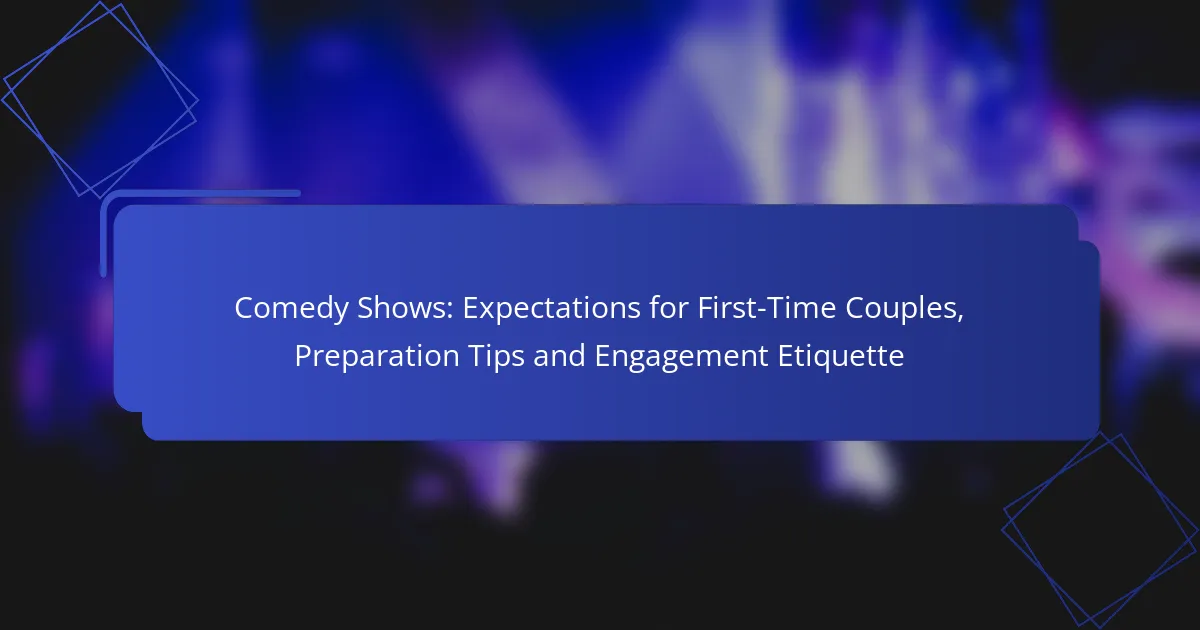In comedy shows, effective audience engagement is crucial for creating a memorable experience. Performers can enhance this connection by using relatable humor, encouraging participation, and maintaining a lively atmosphere. It’s essential to prioritize respect and sensitivity during interactions, ensuring personal boundaries are honored while managing hecklers with a balance of humor and assertiveness.

How can performers engage audiences effectively in comedy shows?
Performers can engage audiences effectively in comedy shows by using humor that resonates with the crowd, encouraging participation, and employing techniques that foster a lively atmosphere. These strategies help create a connection between the performer and the audience, enhancing the overall experience.
Use relatable humor
Relatable humor connects with the audience’s everyday experiences, making jokes more impactful. Performers should draw from common situations, cultural references, or shared emotions that resonate with the demographic present. This approach not only garners laughter but also fosters a sense of community among audience members.
For example, jokes about local customs, current events, or universal challenges can create a bond with the audience. Tailoring humor to the specific audience can significantly increase engagement and enjoyment.
Encourage audience participation
Encouraging audience participation can energize a comedy show and make attendees feel more involved. Performers can ask questions, invite volunteers on stage, or create interactive segments that require audience input. This involvement can lead to spontaneous humor and memorable moments.
However, it’s essential to gauge the audience’s willingness to participate; some may prefer to observe rather than engage. A good performer reads the room and adapts their approach accordingly to ensure everyone feels comfortable.
Incorporate improvisation techniques
Improvisation techniques allow performers to adapt their material based on audience reactions and interactions. By being flexible and spontaneous, comedians can create unique moments that resonate with the crowd. This approach often leads to unexpected humor and keeps the performance fresh.
Practicing improvisation can help performers develop quick thinking and responsiveness. Techniques such as “yes, and…” can enhance interactions and lead to more dynamic exchanges with the audience.
Utilize storytelling
Storytelling is a powerful tool in comedy that helps engage audiences by providing context and emotional depth. A well-told story can draw listeners in, making them more receptive to humor. Performers should focus on crafting narratives that include relatable characters and situations.
Incorporating personal anecdotes or fictional tales that reflect shared experiences can enhance relatability. A good story often sets up the punchline, making the humor more effective and memorable.
Maintain eye contact
Maintaining eye contact with the audience fosters a connection and makes the performance feel more personal. It signals confidence and helps performers gauge audience reactions, allowing them to adjust their delivery as needed. Eye contact can also create a sense of intimacy, making the audience feel directly involved in the show.
Performers should practice looking around the room and engaging with different sections of the audience. Avoiding excessive focus on notes or the stage can enhance the overall engagement level and keep the audience attentive.

What etiquette should performers follow during audience interaction?
Performers should prioritize respect and sensitivity during audience interactions to create a positive experience. This includes being aware of personal boundaries, avoiding controversial subjects, and responding appropriately to audience feedback.
Respect personal space
Maintaining personal space is crucial during audience interaction. Performers should avoid getting too close to audience members unless invited, as this can make people uncomfortable. A good rule of thumb is to keep a distance of at least an arm’s length when engaging with individuals in the crowd.
Additionally, be observant of body language. If someone appears tense or steps back, it’s essential to respect their space and adjust your approach accordingly. This consideration helps foster a welcoming environment.
Avoid offensive topics
Steering clear of offensive topics is vital for maintaining a respectful atmosphere. Subjects such as politics, religion, or sensitive personal issues can alienate audience members and detract from the performance. Instead, focus on universally relatable themes that encourage laughter and connection.
When in doubt, consider the demographic of your audience. Tailoring your material to suit the cultural norms and values of the crowd can prevent misunderstandings and ensure everyone feels included.
Be mindful of audience reactions
Being attuned to audience reactions can significantly enhance the performance. Pay attention to laughter, applause, or silence, as these cues indicate how well your material is resonating. Adjust your pacing and content based on their feedback to keep the energy lively.
If an audience member reacts negatively, it’s important to address the situation gracefully. Acknowledge their discomfort without escalating the issue, and pivot to a different topic or joke to maintain a positive atmosphere.

How can performers handle hecklers in comedy shows?
Performers can effectively manage hecklers by maintaining control of the situation while keeping the audience engaged. The key is to balance humor with assertiveness to ensure the show continues smoothly without escalating tensions.
Use humor to defuse tension
Humor is a powerful tool for addressing hecklers. By responding with a witty remark or a light-hearted joke, performers can turn a potentially disruptive situation into a moment of laughter. This approach not only entertains the audience but also disarms the heckler, reducing the likelihood of further interruptions.
For example, if a heckler shouts something inappropriate, a performer might reply with a playful comment like, “Thanks for your input, but I think my therapist would prefer I stick to my set!” This keeps the atmosphere light while asserting control.
Set clear boundaries
Establishing boundaries is crucial for managing hecklers. Performers should communicate their expectations early in the show, making it clear that while audience interaction is welcome, disruptive behavior will not be tolerated. This can be done through a brief pre-show announcement or a humorous comment during the performance.
For instance, saying something like, “Feel free to laugh, but if you start a debate, I’ll have to charge you for therapy!” sets a playful tone while establishing limits. This proactive approach can deter hecklers from interrupting further.
Engage with wit
Engaging with wit allows performers to turn heckling into a part of the show. Quick, clever responses can showcase the performer’s skills while keeping the audience entertained. This not only helps to manage the heckler but can also enhance the overall experience for the audience.
For example, if a heckler makes a comment about the performer’s outfit, a witty comeback like, “I appreciate your fashion advice, but I think I’ll stick with my stylist!” can create a humorous exchange that captivates the audience. This technique reinforces the performer’s confidence and maintains the show’s momentum.

What are the best practices for audience engagement in major cities?
Effective audience engagement in major cities involves understanding local preferences and fostering a connection with the crowd. Performers should prioritize cultural relevance and interactive elements to create memorable experiences.
Tailor content to local culture
Adapting your material to reflect the local culture is crucial for resonating with the audience. This means considering regional values, humor styles, and social norms. For example, a performer in New York might focus on fast-paced, witty banter, while one in Nashville could incorporate storytelling with a slower rhythm.
Researching the local scene can provide insights into what topics are sensitive or popular. Engaging with local customs and traditions can enhance relatability and show respect for the audience’s background.
Incorporate local references
Using local references can significantly boost audience engagement. Mentioning well-known landmarks, local celebrities, or current events can create a sense of familiarity and connection. For instance, referencing a popular sports team or a recent city event can draw laughter and applause.
However, be cautious not to alienate audience members who may not share the same knowledge. Striking a balance between local references and universal themes ensures that everyone feels included in the performance.
Utilize social media for interaction
Social media platforms are powerful tools for enhancing audience interaction before, during, and after a show. Performers can engage fans through polls, Q&A sessions, or live updates, creating anticipation and excitement. Encouraging audience members to share their experiences online can amplify reach and foster community.
During performances, consider incorporating live social media feeds or hashtags to encourage real-time interaction. This not only engages the audience but also creates a shared experience that can be revisited online, extending the performance’s impact beyond the venue.

What are the prerequisites for effective audience engagement?
Effective audience engagement requires understanding your audience and adapting your performance accordingly. Key prerequisites include knowing the demographics of your audience and employing appropriate interaction techniques to foster a connection.
Understand audience demographics
Understanding audience demographics involves recognizing the age, interests, and cultural backgrounds of your viewers. This knowledge helps tailor your material to resonate with them, increasing the likelihood of a positive response.
For instance, a comedy show aimed at a younger audience may incorporate contemporary references and social media trends, while a performance for an older crowd might focus on nostalgia and classic humor. Adjusting your content based on these factors can significantly enhance engagement.
To effectively gauge demographics, consider using surveys or social media insights before the show. Additionally, observing audience reactions during the performance can provide real-time feedback, allowing for adjustments to your approach as needed.



